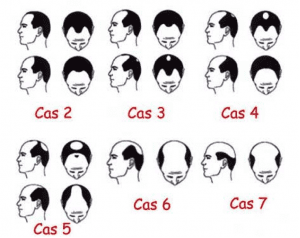HAIR TRANSPLANTS
At CMMA, you benefit from innovative technologies and experienced doctors for hair that lasts a lifetime!
What our patients say:


There is a solution for every type of hair loss!
Type 2–3: moderate hair loss
Type 4–5: advanced hair loss
Type 6–7: severe hair loss
Hair transplants: diagnosis and solutions
Why do we lose our hair?
Hair loss is most influenced by sex hormones and genetics.
It is quite rare for a woman in good health to lose her hair whilst for men it’s quite a common phenomenon. Why?
In men, hair is divided into two distinct regions:
- One region which is not affected by androgens (i.e. male hormones)
- And a second, so-called androgen-sensitive region
This division is hereditary. Hair in the sensitive region will fall out leading to the disappearance of the hair bulbs that produce hair. The various genetic distributions of this hair loss are described in the Hamilton-Norwood scale of male pattern baldness.
This will help you to determine your type of hair loss.
Thanks to the micrograft hair transplant, you can have hair for life.
Hair grafts, also known as hair implants or hair transplants, are carried out by the highly experienced team at Hair-for-Life.
The team at Hair-for-Life is fully trained in this autograft transplant procedure. Thanks to this technique, grafts are not rejected and hair will continue to grow for life. Micrograft hair transplants are a routine procedure.
Hair transplants are carried out at our medical centre in Geneva, which is backed by many years of experience. Each procedure is quick and pain-free. Your hair will grow back at the transplant site.
Which you will see for yourself.
No hair prosthesis is needed.
YOUR HAIR WILL GROW BACK FOR LIFE! Read what our patients have to say and have a good look at the photos and results!
Solutions and techniques
FAQ


